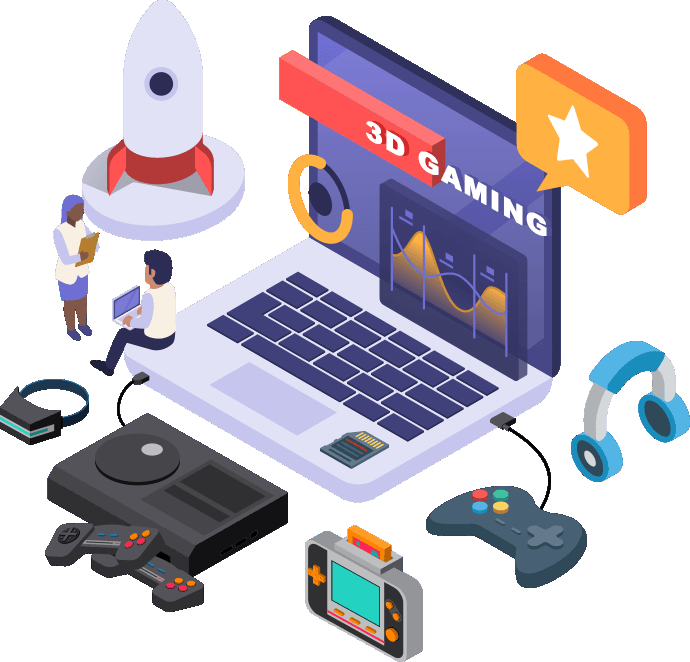The Art of Game Development: A Comprehensive Guide for Beginners
Are you a budding game developer looking to create your own masterpiece? Or perhaps you’re just curious about the world of game development and want to learn more. Either way, this comprehensive guide is for you! From conceptualizing ideas to coding and releasing your finished product, we’ll take you through every step of the process. So grab a pen and paper (or fire up your computer) because it’s time to dive into the art of game development!
What Is Game Development?
Game development is the process of designing and creating video games. It involves everything from the initial concept and story to the programming, art, and music. The game development process can be divided into a number of different stages, each with its own challenges and tasks.
The first stage of game development is pre-production. This is when the team comes up with the initial idea for the game and starts to put together a plan. The second stage is production when the team starts to build the game itself. This includes programming, creating artwork, and recording music.
The third stage is post-production when the team finishes developing the game and prepares it for release. This includes testing to ensure that everything works as intended, as well as polishing the game’s graphics and audio. The fourth stage is release when the game is made available to players.
Game development is a complex process that requires a great deal of skill and experience. However, it can be an extremely rewarding experience to see your vision come to life in a finished product that others can enjoy.
Tools and Software for Game Development
The tools and software you need for game development depend on the type of games you want to create. For example, if you want to create 2D games, you might need a different set of tools than if you were creating 3D games.
Some common tools and software used for game development include:
A Game Engine
This is the foundation that your game will be built on and typically includes a rendering engine, physics engine, collision detection, and other core components. Unity3D and Unreal Engine 4 are two popular examples of game engines.
A Level Editor
This tool is used to create the levels or environments in your game. It typically includes features like terrain manipulation, object placement, lighting, and so on.
3D Modeling Software
If your game uses 3D graphics, you’ll need to create or acquire models of objects like characters, buildings, vehicles, etc. Blender is a popular open-source 3D modeling program.
Animation Software
This is used to create animations for characters and other objects in your game. Autodesk Maya is a popular choice for animation software.
Audio Editing Software
This is used for creating and manipulating sounds and music for your game. Audacity is a popular free audio editor.
Different Types of Games
There are many different types of games that can be developed, from simple 2D mobile games to complex 3D console games. The type of game you develop will depend on your skill set and experience, as well as the resources available to you.
2D Games
2D games are typically simpler than 3D games and can be developed for a variety of platforms including web, mobile, and desktop. These games often use sprites or tile-based graphics and require less processing power than 3D games. Common 2D genres include platformers, puzzle games, and shoot ’em-ups.
3D Games
3D games are more complex than 2D games and require more powerful hardware to run properly. These games typically use polygonal graphics and can be played on consoles, PC, and mobile devices. Popular 3D genres include first-person shooters (FPS), third-person action adventures (TPP), and open-world sandbox games.
Virtual Reality Games
Virtual reality (VR) is a relatively new technology that is slowly becoming more popular in the gaming industry. VR allows players to immerse themselves in a digital world using a headset and controller(s). VR games can be either 2D or 3D, but are typically more immersive than traditional video games.
Principles of Game Design
The principles of game design are the building blocks that are used to create a video game. These principles can be used to create any type of game, from a simple puzzle game to a complex role-playing game. By understanding and applying these principles, you can make your own games that are fun and challenging for players.
First Principle
The first principle of game design is player interaction. This is the core of what makes a game fun and interesting to play. Without player interaction, there is no reason for players to keep coming back to your game. There are many ways to create player interaction, but the most important thing is to make sure that players have something to do in their game. They should be able to make choices that affect the outcome of the game, and they should feel like they are in control of their experience.
Second Principle
The second principle of game design is feedback. Feedback is important because it lets players know how well they are doing in the game. It also helps them understand what they need to do in order to improve their performance. Good feedback should be immediate, clear, and concise. It should also be meaningful; players should feel like their actions have an impact on the course of the game.
Third Principle
The third principle of game design is balance. Balance is important because it keeps players engaged in the game by providing challenges without frustration. If a game is too easy, players will get bored quickly; if it’s too hard, players will give up in frustration. The key
Popular Genres for Game Development
There are a variety of popular genres for game development, each with its own unique challenges and gameplay elements. Here is a brief overview of some of the most popular genres:
Action Games
Action games are fast-paced and often involve combat or other challenges that require quick reflexes. They can be either single-player or multi-player, and many action games also include elements of other genres, such as adventure or puzzle-solving.
Adventure Games
Adventure games usually have a strong focus on storytelling, exploration, and puzzle-solving. They often take place in fantastical settings, such as ancient ruins or exotic locations. Many adventure games also include elements of action, such as combat or platforming sections.
Role-Playing Games (RPGs)
RPGs typically emphasize characters and stories over fast-paced action. They often give players a lot of freedom to customize their characters and choose how to progress through the game world. Many RPGs also feature turn-based combat instead of real-time combat.
Strategy Games
Strategy games challenge players to make clever decisions in order to win. They can be either turn-based or real-time and often involve managing large groups of units or resources. Popular strategy genres include tower defense, real-time tactics, and 4X (explore, expand, exploit, exterminate).
These are just a few of the most popular genres for game development! There are many others to explore, so don’t be
How To Market Your Games
When it comes to marketing your games, there are a number of different strategies you can use to get the word out.
Here are a few tips to get you started:
Use social media to your advantage
Platforms like Twitter and Facebook are great for promoting your games and reaching out to potential players. Make sure to post regular updates and interact with your followers to keep them engaged.
Get involved in the gaming community
There are tons of online forums and communities dedicated to gaming. Find ones that align with your game genre and get involved in the discussions. This is a great way to get exposure for your games and connect with other like-minded gamers.
Use influencers to reach a wider audience
If you can identify influential gamers or streamers in your genre, reach out to them and see if they’d be interested in featuring your game on their channel or blog. This can be a great way to reach new players who might not otherwise know about your game.
Utilize paid advertising platforms
Platforms like Google AdWords and Facebook Ads can be effective ways to reach new players with targeted ads for your game. Just be sure to set a budget and track your results so you know what’s working and what isn’t.
Run contests or giveaways
Offering free copies of your game or other prizes is a great way to generate interest and excitement around your game.
Challenges in Game Development
There are many challenges that come with game development, especially for beginners. The most common challenge is simply getting started. With so many different aspects to game development, it can be difficult to know where to begin.
Another common challenge is finishing the game. It is not uncommon for developers to get bogged down in the details or lose motivation halfway through development. It is important to set realistic goals and deadlines to ensure that the project does not become overwhelming.
Perhaps the most difficult challenge of all is making a fun and enjoyable game. There is no guarantee that a game will be successful, no matter how well it is made. Ultimately, it is up to the players to decide whether they enjoy playing it. However, there are certain elements that can make a game more likely to be enjoyed, such as an engaging story, interesting gameplay mechanics, and likable characters.
Tips for Beginners
When it comes to game development, there are a few key things that beginners need to keep in mind in order to be successful. First and foremost, it is important to have a clear vision of what you want your game to be. Once you have a solid idea of the game you want to create, it is important to start planning out the different aspects of the game. This includes everything from the story and gameplay mechanics to the art style and audio.
Once you have a good understanding of what your game will entail, it is time to start putting together a team. If you are working on a small-scale project, then you may be able to do everything yourself. However, for most games, it is necessary to enlist the help of others in order to get the job done. When assembling your team, it is important to make sure that everyone is on the same page and shares your vision for the game.
After your team is in place, the next step is to start working on the actual development of the game. This process can be broken down into a few different stages, including pre-production, production, and post-production. In pre-production, you will focus on getting all of the assets and resources together that you will need for production. This includes everything from concept art to 3D models and animations. During production, you will actually put all of these assets together and create the game itself. During post-production, you will focus on
Conclusion
At the end of the day, game development is an art form that requires a great deal of creativity, technical skill, and dedication. If you have taken on this challenge as a beginner, we hope that this guide has provided you with some insight into the process of creating your own game. With enough practice and perseverance, you can create something truly unique that will bring joy to players all over the world. Keep learning and pushing yourself to reach new heights in game development!
















